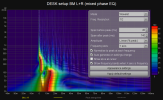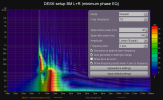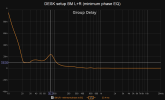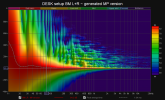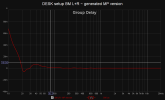Recently I have been playing around with some high-pass filters on my system (these are my fronts and these are my rears)
For music I don't really need a high-pass filter but when I run some Dolby or DTS tests or watch a movie at high volume levels I need to apply a high-pass filter to prevent audible over-excursion of the drivers.
Now some wavelet diagrams:
1. This is how it looks like when the frequency response is ruler flat:

2. This is how it looks like when I apply a 4.5dB high-shelf from 100Hz with Q=1
The colours at the bottom moved a bit more towards red since energy in that frequency range became higher + both pre- and post ringing became a little bit higher
I guess this is all just fine

3. Now let's apply an additional high-pass filter at 23Hz with 24dB/octave:
Woow, looks pretty bad! (at least to me)
Pre-ringing is gone (need to add though that it was NOT audible at all previously either) but post-ringing just went up the roof
The energy peak has been shifted to the right by 25ms and there is still heavy oscillation till around 65ms....

4. OK, let's try the same high-pass filter but this time in linear phase mode
Another Woooow!
Now my wavelet seems a lot more like the one without the high-pass filter...
Pre-ringing is a bit less and even post-ringing became smaller (look at the colours just next to 0ms to the right)

I am not an engineer and never studied linear system theory so I would really appreciate if somebody could please explain what I see here
To me the linear phase diagram looks like lightyears better vs the minimum phase one but when I listen to them actually I do not hear a huge difference - I am not even sure I would pass a double blind test....
Any comments would be appreciated
Thank you
EDIT: these are all actual measurements at the MLP, they are not simulations! For the filters I used the latest version of CraveEQ (and I strongly suspect that I would have ended up with same/similar results with other solutions too)
For music I don't really need a high-pass filter but when I run some Dolby or DTS tests or watch a movie at high volume levels I need to apply a high-pass filter to prevent audible over-excursion of the drivers.
Now some wavelet diagrams:
1. This is how it looks like when the frequency response is ruler flat:
2. This is how it looks like when I apply a 4.5dB high-shelf from 100Hz with Q=1
The colours at the bottom moved a bit more towards red since energy in that frequency range became higher + both pre- and post ringing became a little bit higher
I guess this is all just fine
3. Now let's apply an additional high-pass filter at 23Hz with 24dB/octave:
Woow, looks pretty bad! (at least to me)
Pre-ringing is gone (need to add though that it was NOT audible at all previously either) but post-ringing just went up the roof
The energy peak has been shifted to the right by 25ms and there is still heavy oscillation till around 65ms....
4. OK, let's try the same high-pass filter but this time in linear phase mode
Another Woooow!
Now my wavelet seems a lot more like the one without the high-pass filter...
Pre-ringing is a bit less and even post-ringing became smaller (look at the colours just next to 0ms to the right)
I am not an engineer and never studied linear system theory so I would really appreciate if somebody could please explain what I see here
To me the linear phase diagram looks like lightyears better vs the minimum phase one but when I listen to them actually I do not hear a huge difference - I am not even sure I would pass a double blind test....
Any comments would be appreciated
Thank you
EDIT: these are all actual measurements at the MLP, they are not simulations! For the filters I used the latest version of CraveEQ (and I strongly suspect that I would have ended up with same/similar results with other solutions too)

